Table of Contents

UNIT FIVE
Markets
Teacher’s note
These two chapters focus on aspects of life and commercial cycles associated with markets. While some of these processes may be visible and, therefore, easily observable, there are also others that are relatively unfamiliar.
Chapter 7 discusses ‘Markets Around Us’. At one level, we study different market sites: a weekly market, neighbourhood shops, a shopping complex, etc. At another level, we explore the intricate question, ‘how do goods reach these markets?’ We examine how a chain of markets operates and the role of wholesale markets within this, through the case study of a wholesale vegetable market. We usually associate ‘market’ with marketplaces, but buying and selling takes place in diverse ways and the chapter discusses how all of this falls within a larger understanding of markets.
Chapter 8 looks at how markets offer people different opportunities. This is done through the ‘story of a shirt’, and the chain of markets involved in the process. Together with understanding each step of the manufacture and circulation of a shirt, we realise that some people stand to gain in the market transaction whereas others do not gain as much, or none at all. The opportunities are highly unequal. Ways do exist, such as those of cooperative marketing, which can provide a better return to the producers. However, we need to find many more viable avenues for equitable distribution.
These chapters offer an opportunity of bringing in the experience of local markets for discussion in the classroom. A visit to a wholesale market would be of interest, and would allow the learner to find out the profit margins and details of daily earnings so that those inequalities can be directly examined. The experiences of markets are varied and also quite rich. Hence, one should allocate time for some questions, not addressed in the text, which students may wish to discuss.

CHAPTER 7
Markets Around Us

We go to the market to buy many things – vegetables, soap, toothpaste, masala, bread, rice, dal, clothes, notebooks, biscuits, etc. If we make a list of the goods that we purchase, it would be really long. There are many kinds of markets that we may visit for our everyday needs: these can include shops, hawker’s stalls in our neighbourhood, a weekly market, a large shopping complex, perhaps even a mall. In this chapter, we look at some of these markets and try to understand how the goods that are sold there reach buyers, who these buyers are, who these sellers are, and the sorts of problems they face.
Why do people go to a weekly market? Give three reasons.
Who are the sellers in a weekly market? Why don’t we find big business persons in these markets?
Why are things cheap in the weekly market?
Explain with an example how people bargain in the market. Can you think of a situation where the bargain would be unfair?
Weekly market
A weekly market is so called because it is held on a specific day of the week. Weekly markets do not have permanent shops. Traders set up shops for the day and then close them up in the evening. Then they may set up at a different place the next day. There are thousands of such markets in India. People come here for their everyday requirements.
Many things in weekly markets are available at cheaper rates. This is because when shops are in permanent buildings, they incur a lot of expenditure – they have to pay rent, electricity, fees to the government. They also have to pay wages to their workers. In weekly markets, these shop owners store the things they sell at home. Most of them are helped by their family members and, hence, do not need to hire workers. Weekly markets also have a large number of shops selling the same goods which means there is competition among them. If some trader were to charge a high price, people would move to another shop where the same thing may be available more cheaply or where the buyer can bargain and bring the price down.
Sameer: Seller of clothes
Sameer is a small trader in the weekly market. He buys clothes from a large trader in the town and sells them in six different markets in a week. He and other cloth sellers move in groups. They hire a mini van for this. His customers are from villages that are near the marketplace. At festival times, such as during Deepavali or Pongal, he does good business.
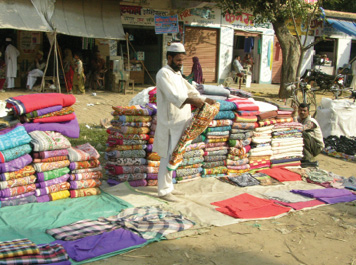
One of the advantages of weekly markets is that most things you need are available at one place. Whether you want vegetables, groceries or cloth items, utensils – all of them can be found here. You do not have to go to different areas to buy different things. People also prefer going to a market where they have a choice and a variety of goods.
Shops in the neighbourhood
We have seen that the weekly markets offer a variety of goods. However, we also buy things from other kinds of markets. There are many shops that sell goods and services in our neighbourhoods. We may buy milk from the dairy, groceries from departmental stores, stationery, eatables or medicines from other shops. Many of these are permanent shops, while others are roadside stalls such as that of the vegetable hawker, the fruit vendor, the mechanic, etc.
Sujata and Kavita were sent to buy groceries from their neighbourhood shop. This was the shop they usually went to. It was crowded today. The shop owner managed the shop herself with two helpers. When they managed to get into the shop, Sujata dictated a list to her. She in turn began asking her helpers to weigh and pack the items. Meanwhile Kavita looked around…
On the top left shelf there were different brands of detergent cakes. Another shelf had toothpastes, talcum powder, shampoo, hair oil. The different brands and different colours looked so attractive. On the floor lay a few sacks.
It took almost 20 minutes to weigh and pack all the groceries. Then Sujata showed her “notebook.” The woman noted the amount of
` 3000 in the notebook and gave it back. She also noted the amount in her big register. Then Sujata took the heavy bags out of the shop. Her family will pay for the purchases in the first week of next month.
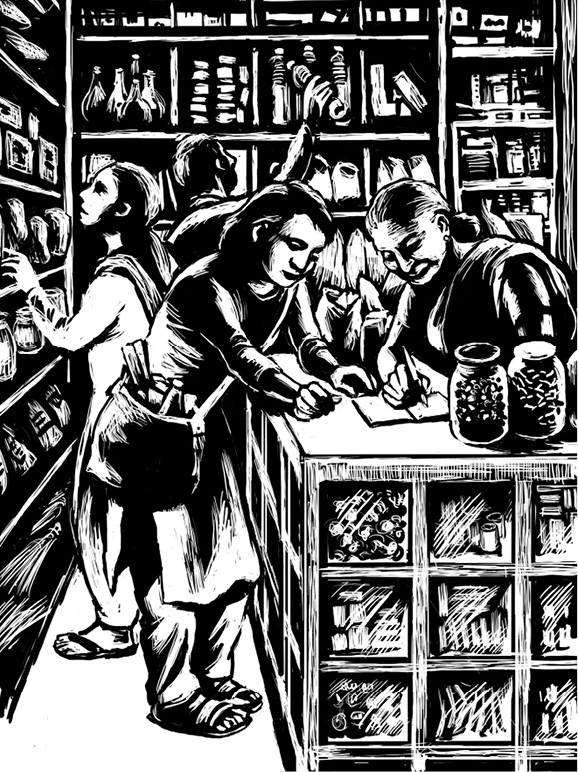
Why did Sujata carry a notebook? Do you think this system is useful? Can there be problems?
What are the different kinds of shops that you find in your neighbourhood? What do you purchase from them?
Why are goods sold in permanent shops costlier than those sold in the weekly markets or by roadside hawkers?
Shops in the neighbourhood are useful in many ways. They are near our home and we can go there on any day of the week. Usually, the buyer and seller know each other and these shops also provide goods on credit. This means that you can pay for the purchases later, as we saw in Sujata’s case, for example.
You might have noticed that there are different kinds of sellers even in the neighbourhood markets. Some of them have permanent shops and others sell their goods on the roadside.
Anzal Mall is a five-floor shopping complex. Kavita and Sujata were enjoying going up and down in the lift. It seemed as if it was made of glass and they were able to see outside as they went up. It was fascinating to see so many different kinds of shops such as the ice-cream, burger, pizza and other food shops; shops full of home appliances; footwear and leather items as well as bookshops.
While wandering about on the third floor they entered a shop that was selling branded ready-made clothes.The security guard looked at them as if he wanted to stop them but he did not say anything. They looked at some dresses and then looked at the price tag. None of them was less than ₹ 3,000, almost five times the weekly market price! Sujata whispered to Kavita, “I’ll take you to another shop which has good quality ready-made clothes at more reasonable prices”.
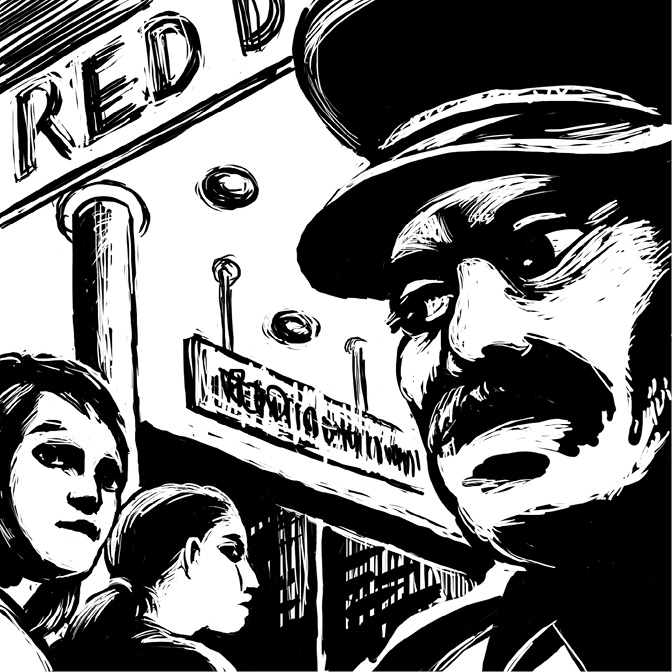
Shopping complexes and malls
Why do you think the guard wanted to stop Kavita and Sujata from entering the shop? What would you say if someone stops you from entering a shop in a market?
So far we have seen two kinds of marketplaces – weekly markets and markets in our neighbourhood. There are other markets in the urban area that have many shops, popularly called shopping complexes. These days, in many urban areas, you also have large multi-storeyed air-conditioned buildings with shops on different floors, known as malls. In these urban markets, you get both branded and non-branded goods. As you have read in the chapter on advertising, branded goods are expensive, often promoted by advertising and claims of better quality. The companies producing these products sell them through shops in large urban markets and, at times, through special showrooms. As compared to non-branded goods, fewer people can afford to buy branded ones.
Why do people not bargain in shops located in malls whereas they bargain in weekly markets?
Chain of markets
In the previous sections, you have read about different markets from where we buy goods. From where do you think shop-owners procure their goods? Goods are produced in factories, on farms and in homes. However, we don’t buy directly from the factory or from the farm. Nor would the producers be interested in selling us small quantities such as one kilo of vegetables or one plastic mug.
How do you think your neighbourhood shop gets its goods? Find out and explain with some examples.
Why is a wholesale trader necessary?
The people in between the producer and the final consumer are the traders. The wholesale trader first buys goods in large quantities. For example, the vegetable wholesale trader will not buy a few kilos of vegetables, but will buy in large lots of 25 to 100 kilos. These will then be sold to other traders. In these markets, buying and selling takes place between traders. It is through these links of traders that goods reach faraway places. The trader who finally sells this to the consumer, is the retailer. This could be a trader in a weekly market, a hawker in the neighbourhood or a shop in a shopping complex.

The above map of Delhi shows four of the 10 wholesale markets in the city.
We can understand this with the help of the following examples –
Every city has areas for wholesale markets. This is where goods first reach and are then supplied to other traders. The roadside hawker whom you read about earlier would have purchased a large quantity of plastic items from a wholesale trader in the town. He, in turn, might have bought these from another, even bigger wholesale trader in the city. The city wholesale trader would have bought a large quantity of plastic items from the factory and stored them in a godown. In this way, a chain of markets is set up. When we purchase, we may not be aware of the chain of markets through which these goods travel before they reach us.
Aftab–The wholesaler in the city
Aftab is one of the wholesale traders who purchases in bulk. His business starts around 2 o’clock in the morning when vegetables reach the market. This is the time when the vegetable market or mandi starts buzzing with activity. The vegetables come in trucks, matadors, tractor trolleys from farms both near and far. Soon the process of auctions begins. Aftab participates in this auction and decides what he will buy. Today, for example, he bought 5 quintals of cauliflower, 10 quintals of onions. He has a shop in the market where he stores the vegetables that he has bought. From here he sells to hawkers and shopkeepers who start coming to the market around six in the morning. They have to organise their purchases so that they can start their shop for the day around ten in the morning.
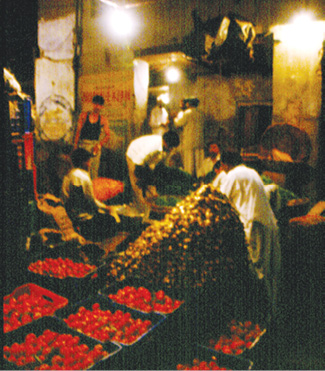
Markets everywhere
So far we have seen different marketplaces where people buy and sell a variety of goods and services. All these markets are in a specific locality and work in a particular manner and time. However, it is not always necessary that one has to go to the market to purchase goods. You can place orders for a variety of things through the phone and these days through the Internet, and the goods are delivered at your home. In clinics and nursing homes, you may have noticed sales representatives waiting for doctors. Such persons are also engaged in the selling of goods. Thus, buying and selling takes place in different ways, not necessarily through shops in the market.
The markets that we looked at above are the ones that we recognise easily. However, there are markets that we may not be so aware of. This is because a large number of goods are bought and sold that we don’t use directly. For example, a farmer uses fertilisers to grow crops that he purchases from special shops in the city and they, in turn get them from factories. A car factory purchases engine, gears, petrol tanks, axles, wheels, etc. from various other factories. We don’t usually see all the buying and selling, but only the final product – the car in the showroom. The story is similar for any other good.
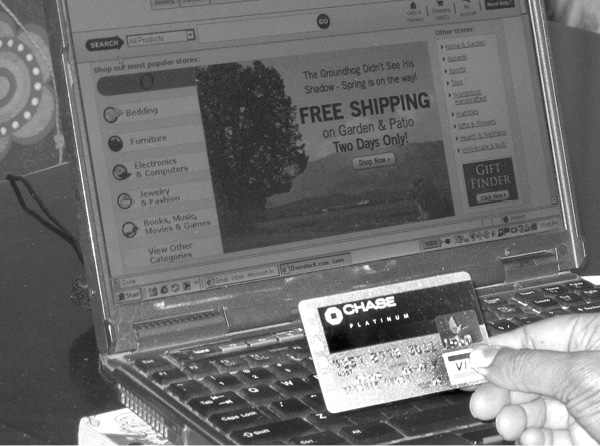
People in urban areas can enter markets without stepping out of their homes via the Internet. They use their credit cards to make ‘online purchases’.
Markets and equality
In this chapter, we have looked at shop owners in a weekly market and those in a shopping complex. They are very different people. One is a small trader with little money to run the shop whereas the other is able to spend a lot of money to set up the shop. They also earn unequal amounts. The weekly market trader earns little compared to the profit of a regular shop owner in a shopping complex. Similarly, buyers are differently placed. There are many who are not able to afford the cheapest of goods while others are busy shopping in malls. Thus, whether we can be buyers or sellers in these different markets depends, among other things, on the money that we have.
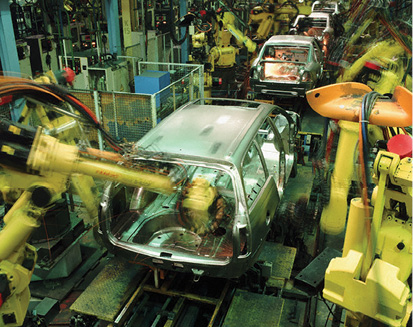
A car being put together in a factory.
We have also examined the chain of markets that is formed before goods can reach us. It is through this chain that what is produced in one place reaches people everywhere. When things are sold, it encourages production and new opportunities are created for people to earn. However, do they offer equal opportunities? We will try to understand this through the story of a shirt in the next chapter.
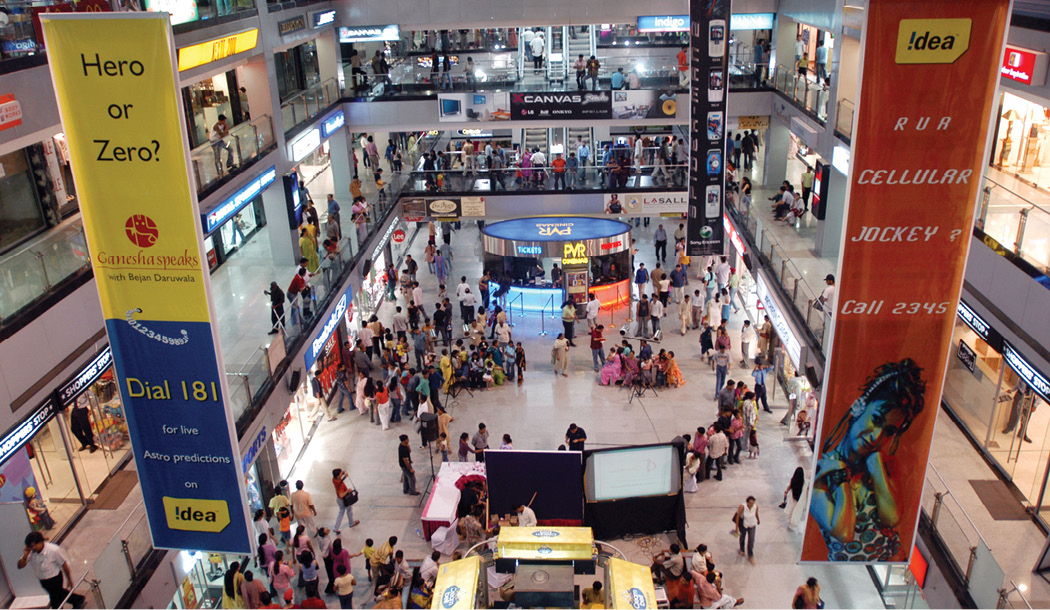
Malls, like the one above, sell expensive and branded goods.

Sustainable Development Goal (SDG)
www.in.undp.org
EXERCISES
1. In what ways is a hawker different from a shop owner?
2. Compare and contrast a weekly market and a shopping complex on the following:
| Market | Kind of goods sold | Prices of goods | Sellers | Buyers |
| Weekly market | ||||
| Shopping complex |
3. Explain how a chain of markets is formed. What purpose does it serve?
4. ‘All persons have equal rights to visit any shop in a marketplace.’ Do you think this is true of shops with expensive products? Explain with examples.
5. ‘Buying and selling can take place without going to a marketplace.’ Explain this statement with the help of examples.
Glossary
Weekly market: These markets are not daily markets but are to be found at a particular place on one or maybe two days of the week. These markets most often sell everything that a household needs ranging from vegetables to clothes to utensils.
Mall: This is an enclosed shopping space. This is usually a large building with many floors that has shops, restaurants and, at times, even a cinema theatre. These shops most often sell branded products.
Wholesale: This refers to buying and selling in large quantities. Most products, including vegetables, fruits and flowers have special wholesale markets.
Chain of markets: A series of markets that are connected like links in a chain because products pass from one market to another.

